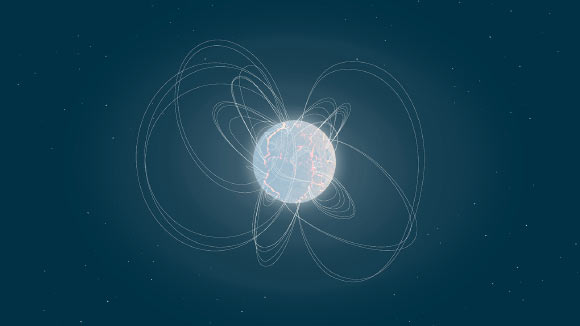Using NASA’s Neil Gehrels Swift Observatory, ESA’s XMM-Newton observatory, NASA’s Nuclear Spectroscopic Telescope Array (NuSTAR), and ground-based telescopes, astronomers have detected a hard X-ray burst, a long-lived outburst and a number of strong and short radio pulses from an infant neutron star with a magnetic field some 70 quadrillion times stronger than that of Earth. Named Swift J1818.0-1607, the object emitted X-rays about 16,000 years ago, when it was about 240 years old.
Source: Sci News
Swift J1818.0-1607 resides in the constellation of Sagittarius, about 16,000 light-years away.
It has a magnetic field up to 1,000 times stronger than a typical neutron star and belongs to a special class of objects called magnetars.
At about 240 years old, Swift J1818.0-1607 is both the youngest neutron star and the youngest magnetar ever discovered.
It is also one of the fastest-spinning such objects known, whirling around once every 1.36 seconds — despite containing the mass of two solar masses within a stellar remnant measuring just 25 km across.
“This object is showing us an earlier time in a magnetar’s life than we’ve ever seen before, very shortly after its formation,” said Dr. Nanda Rea, an astronomer at the Institute of Space Sciences.
While there are over 3,000 known neutron stars, astronomers have identified just 31 confirmed magnetars — including this newest entry.
“Swift J1818.0−1607 lies around 16,000 light-years away, within the Milky Way,” said Dr. Paolo Esposito, an astronomer at the University School for Advanced Studies IUSS Pavia and the INAF – Istituto di Astrofisica Spaziale e Fisica Cosmica di Milano.
“Spotting something so young, just after it formed in the Universe, is extremely exciting. People on Earth would have been able to see the supernova explosion that formed this baby magnetar around 240 years ago.”
Composite image of Swift J1818.0-1607, the youngest pulsar ever observed, as seen by the EPIC-pn camera on ESA’s XMM-Newton observatory. The image combines observations in the following energy bands: 2-4 keV (red), 4-7.5 keV (green) and 8.5-12 keV (blue). Image credit: ESA / XMM-Newton / P. Esposito et al.
The Neil Gehrels Swift Observatory spotted the magnetar when it began outbursting. In this phase, its X-ray emission became at least 10 times brighter than normal.
Outbursting events vary in their specifics, but they usually begin with a sudden increase in brightness over the course of days or weeks that is followed by a gradual decline over months or years as the magnetar returns to its normal brightness.
The Swift team alerted the global astronomy community to the event, and XMM-Newton and NuSTAR performed quick follow-up studies.
Unlike most magnetars, which are only observable in X-rays, the observation with the Sardinia Radio Telescope taken about one week after the X-ray burst revealed that Swift J1818.0−1607 is one of the very few to also show pulsed emission in radio waves.
“Neutron stars that emit long-lived radio beams are called radio pulsars. Swift J1818.0−1607 is one of five known magnetars that are also radio pulsars,” the researchers said.
The discovery is described in a paper in the Astrophysical Journal Letters.
Source: Sci News

































Leave a Comment
You must be logged in to post a comment.